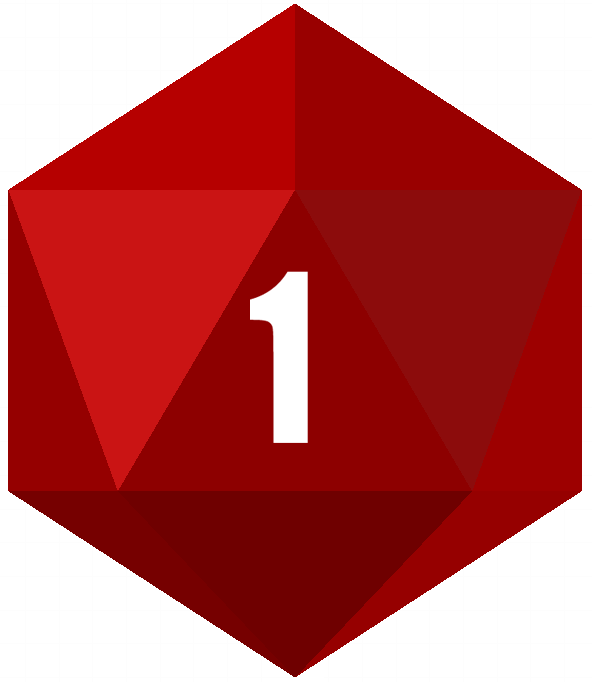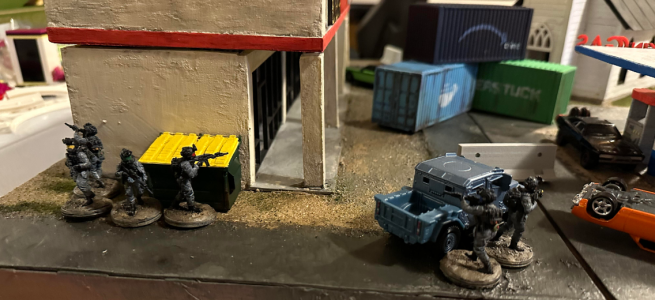I’m testing this shootout minigame for White Line Nightmare. Currently I’m running the same starting scenario through that minigame as well as Savage Worlds, which is a perennial favorite of my group.
The Setup
Three PCs (Yankee, Raven, and Oriole) are up against six bad guys in an abandoned small town.





Savage Worlds
The three PCs were built as Novice characters, well-equipped with the best modern armor and weapons. The opposing fireteam were all basic Soldiers from the back of the book, armed with similar rifles but their armor was one step lower. PCs had a full stock of bennies. I wasn’t testing stealth or The Drop – the combat started with initiative and I went from there.
It started off pretty fast and furious but honestly, the dice turned sour about halfway through and the whiffs (either from plain misses or from poor damage rolls) started to pile up. Savage Worlds does have fairly detailed ranged combat and things like wounds, cover, and multiple actions can all combine to ensure several rounds where nobody hits anything. More experienced characters can mitigate these modifiers either through brute force skill or by taking Edges that ignore or reduce penalties, but my Novice characters won because 1) they had better armor and 2) they went in for melee at the end, where the dice finally flipped in their favor again and started acing every roll. Even after bennies to soak wounds and reroll some stinky results, I was left with two wounded PCs and only 1 benny between all 3 of them.
The main takeaway was that although the end result looked like something I’d want as a GM – ie, the aftermath of a tough encounter that left the PCs looking like they’d won at a cost – in play it dragged more than I expected and I felt myself fishing for aces more than I remembered.
I considered running it again with Seasoned or higher characters loaded up with combat Edges against enemies with higher skill to boost lethality and potentially speed up resolution, but wasn’t I supposed to be playtesting my own game?
-That was quick.
-Yeah, everybody could shoot.
Appaloosa
White Line Nightmare: Shootout
I did have to change the layout and starting positions a little bit, because gunfights in WLN start from the moment you make contact rather than what I’d set up previously, where two forces enter a battlefield on mostly equal footing.

As for our dubious heroes, their relevant White Line Nightmare stats are as follows:
Yankee
- Fast d10
- Assault d10, Evading d8, Stalking d6, Murder d10
- MP7 (submachine gun)
Raven
- Sharp d10
- Assault d8, Evading d10, Stalking d6, Murder d10
- AK101 (assault rifle)
Oriole
- Cold d10
- Assault d8, Evading d6, Stalking d10, Murder d10
- Mk 18 (carbine)
Contact
Unlike Savage Worlds and many other skirmish games, White Line Nightmare is player-facing. It centers the action on the PCs instead of trading off with NPCs in a traditional turn-based paradigm. The first roll in a shootout is the contact roll, where every PC can attempt to move or suppress the enemy before the action really kicks off but at the risk of the opposition gaining the upper hand if their rolls go poorly.

Good News
The encounter ran a lot faster than its Savage Worlds equivalent! Yankee, Raven, and Oriole put down the enemies with only minor injuries to show for it. Because I’m currently using rules that prioritize line of sight, the concept of overwatch happens fairly naturally. In this case, it meant most of my bad guys got downed while positioning for a shot. There were no whiffs – something happened on every roll.

Bad News
My previous playtests were in Roll20 and used floorplans heavily cribbed from classic Call of Duty maps. Corridors and doorways featured much more heavily there than the scatter terrain and partial cover that littered this battlefield. It turns out basing so many of my triggering conditions on line of sight (which makes more sense in room-to-room CQB) also means it feels a little off when it’s super hard to break line of sight, or when it wouldn’t make sense to (like here). There’s also a handling/activation issue where multiple combatants all have sightlines to each other. You shouldn’t want to stand your ground against multiple shooters like Yankee could in this scenario, so I clearly need to adjust the peril there somehow.
Great Success!
I’ve got a lot to think about, some big changes to consider, and many more tests to run.


One thought on “A/B Testing”